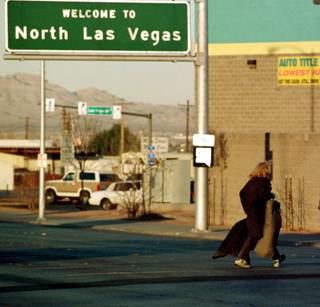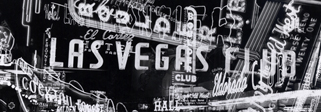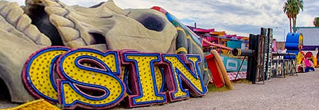Thursday, May 15, 2008 | 3 a.m.
Audio Clip
- North Las Vegas Mayor Michael Montandon on how he discovered North Las Vegas.
-
Audio Clip
- Montandon on the founder's original intentions for the city.
-
Audio Clip
- Michael Montandon on how what sparked the city's inception years ago is still alive today.
-
Audio Clip
- Montandon on Aliante as the 'second city.'
-
Audio Clip
- Montandon on the amount of renovation in downtown North Las Vegas.
-
Just north of the twinkling lights of the Las Vegas Strip is a city founded on the morals of a pious man from Utah, only to be taken over by bootleggers during Prohibition, discrimination by local banks and finally split into two cities by community developers.
North Las Vegas officially became a city May 6, 1946, but its existence dates back 30 years earlier when a man named Thomas Williams moved his family to Las Vegas in 1919 from Eureka, Utah. The ultra-religious Williams disliked any form of government and was weary of the bureaucratic system of city government that had taken over Las Vegas. So instead of settling in the city, he moved his family a few miles north of Las Vegas near what is now Jerry’s Nugget Casino on Las Vegas Boulevard.
Yet to be annexed by either the city or Clark County, the unsettled land was void of law and order. Williams staked out 160 acres for himself and made provisions to sell the remaining 100 acres for $10 per lot.
But it was not until the days of Prohibition that the dusty settlement just north of Las Vegas drew in any takers.
According to the book “Las Vegas: A Centennial History,” Las Vegas had already gained a reputation for its free flow of liquor, gambling and prostitution and was a permanent fixture on the radar of federal agents looking to enforce Prohibition.
Not far down the way were 100 acres free from state, city or federal law. Of the first 80 lots that Williams sold, 31 were bought by moonshine distillers.
“North Las Vegas was a bootleg suburb of Las Vegas,” said Eugene Moehring, a history professor at UNLV and an expert in the urban development of Las Vegas.
The city narrowly escaped annexation by Las Vegas in the 1930s. According to Moehring, North Las Vegas became a martial economy when the government installed a gunnery school at present-day Nellis Air Force Base right before World War II and on through the Cold War. The city served as a weekend hangout spot for servicemen and provided off-base housing for their families.
In the 1960s, North Las Vegas Mayor William Taylor hired Clay Lynch, the city manager who had designed Henderson, to renovate North Las Vegas’ image. Civic Center and the North Las Vegas Library are both results of Taylor’s efforts to give the city a modern look and compete with Las Vegas.
Despite his efforts, red-lining by local banks up until 1971 hindered the city’s attempt to create a suburban community.
According to Moehring, banks literally drew red lines on maps around areas of town that housed minorities and declared them decrepit so they would not have to loan money to them. Without loans to build, the area would eventually fall apart. This practice only perpetuated the notion that minorities ran down the value of neighborhoods.
“You had a lot of red-lining in the 1950s and 1960s on the west side and North Las Vegas,” said Moehring.
With the wheels of discrimination in motion, North Las Vegas had been pigeon-holed as a low income, minority-housing city.
“It took a long time for North Las Vegas to become a city that looked really great,” said Moehring.
It was not until the population explosion that began in the 1980s and continued through the 21st century that North Las Vegas would be able to shed some of its image as a poor, rundown city.
“You needed to have the valley go from 400,000 to 2 million, which happens between 1970 and 2007. It spills over, Las Vegas can’t handle it all, the county can’t handle it all – North Las Vegas,” said Moehring.
North Las Vegas got its population rush, but continued to feel the effects of the red-lining.
“The old North Las Vegas, despite all the efforts, still looks like an old, run down town, lots of vacant lots between buildings,” Moehring said.
In 2002, the community developer Del Webb noticed the expanse of land north of the two communities they had finished in the southwest and southeast parts of Las Vegas.
The master planned community Aliante was born. Complete with a golf course, city parks and trails that lead to housing developments throughout Aliante, North Las Vegas finally had its community.
But, what about old North Las Vegas?
More than 200,000 people still live between Carey Avenue and Craig Road and call North Las Vegas home.
North Las Vegas Mayor Michael Montandon admitted that as the city continues to expand farther west, the harder it has become to maintain one cohesive and united North Las Vegas.
“I wish that I could say that we did it that well, but it’s very, very difficult. And actually now, in the last election, the people voted to break up the council members to vote by ward and that was very divisive. So now people talk about their ward as if it’s a separate city,” said Montandon.
According to Moehring, the old North Las Vegas should not be expecting the Del Webb treatment any time soon.
“They’re pumping all their money into that west part of North Las Vegas, which is the Aliante section, so there’s really like that city with two identities,” Moehring said.
Montandon took issue with that statement though. According to the mayor, downtown North Las Vegas (considered to be the older part) will see plenty of renovation within the next five years including a “plethora of sites zoned for casinos.”
From its days as a pious man’s haven to its time as a Prohibition hide-out, North Las Vegas continues to be a city full of contradictions.


 Explore Las Vegas’ past and present
Explore Las Vegas’ past and present Boomtown: The Story Behind Sin City
Boomtown: The Story Behind Sin City Neon Boneyard: A 360° look
Neon Boneyard: A 360° look Mob Ties: See the connections
Mob Ties: See the connections Implosions: Classic casinos crumble
Implosions: Classic casinos crumble